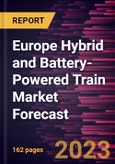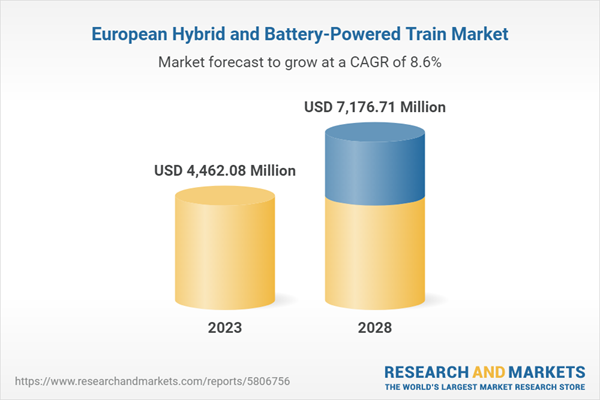The Europe hybrid and battery-powered train market is projected to reach US$ 7.2 billion by 2028, growing at a CAGR of 8.6% from 2023 to 2028.
The increasing demand for energy-efficient transportation is driving the hybrid and battery-powered train market. Governments of various European countries are taking initiatives to reduce carbon emissions. The European Union (EU) has adopted the United Nations (UN) 2030 agenda for sustainable development and the Paris Agreement on climate change. Furthermore, the European Green Deal is a part of the European Commission's strategy to implement the UN 2030 agenda and the Sustainable Development Goals (SDGs). EU is implementing these plans and policies to achieve climate neutrality by 2050. Through this Green Deal, the European Commission is aiming to reduce transport emissions by 90% by 2050. To achieve the goal of reducing carbon emissions, governments of various European countries are adopting fuel-efficient trains, driving the Europe hybrid and battery-powered train market growth.
The pantograph charging system is located on the roof of the train; it helps collect the electricity needed to power the train. Pantographs make direct contact with the overhead power lines in order to obtain electricity. The system provides fast charging with a wide range of power levels, thus, providing an uninterrupted power supply in the train. Pantograph based battery trains from the market players will fuel the segment's growth during the forecast period, promoting the overall Europe hybrid and battery-powered train market growth.
A hybrid train is an energy-saving system that is a combination of a conventional diesel and electric drive system. The train comprises a generator with a combustion engine, one or more electric motors with corresponding power electronics, and a battery. As the hybrid train helps reduce greenhouse gases and other exhaust gas emissions in the environment, its demand in the market is increasing. In addition, the use of a combustion engine as a generator in the hybrid train can help maximize the working time of a combustion engine, thus, improving the efficiency of the entire system by up to 30%. All the above advantages of hybrid trains are increasing their adoption in the market tremendously. Battery-powered trains are one of the cleanest zero-emission solutions. Adopting these trains will help achieve climate change targets by improving air quality in cities and non-electrified stations. Battery-powered trains will also allow traveling beyond electrified routes, providing a seamless journey and an integrated passenger experience that benefits both operators and the environment. Due to all the above benefits of battery-powered trains, their demand is increasing in the region, pushing Europe hybrid and battery-powered train market players to develop innovative products.
The Europe hybrid and battery-powered train market is segmented based on propulsion type, charging system type, and geography. Based on propulsion type, the Europe hybrid and battery-powered train market is segmented into hybrid, battery-powered, and fuel cell. Based on charging system type, the Europe hybrid and battery-powered train market is segmented into pantograph, auxiliary diesel engine, and dock-in. By geography, the Europe hybrid and battery-powered train market is segmented into Germany, France, Italy, Spain, the UK, Poland, Austria, Slovenia, Bulgaria, Hungary, Romania, Greece, Serbia, Scandinavia, Croatia, and the Rest of Europe.
Alstom SA, Westinghouse Air Brake Technologies Corp, Construcciones y Auxiliar de Ferrocarriles SA, Koncar Electrical Industry Inc, Hitachi Rail STS SpA, Hyundai Rotem Co, Siemens Mobility GmbH, CRRC Corp Ltd, Toshiba Infrastructure Systems and Solutions Corporation, and Stadler Rail AG are among the key Europe hybrid and battery-powered train market players operating in the market and profiled in this study.
The overall Europe hybrid and battery-powered train market size has been derived using both primary and secondary sources. Exhaustive secondary research has been conducted using internal and external sources to obtain qualitative and quantitative information related to the Europe hybrid and battery-powered train market. The process also helps obtain an overview and forecast of the market with respect to all the market segments. Also, multiple primary interviews have been conducted with industry participants to validate the data and gain analytical insights. This process includes industry experts such as VPs, business development managers, market intelligence managers, and national sales managers, along with external consultants such as valuation experts, research analysts, and key opinion leaders, specializing in the Europe hybrid and battery-powered train market.
The increasing demand for energy-efficient transportation is driving the hybrid and battery-powered train market. Governments of various European countries are taking initiatives to reduce carbon emissions. The European Union (EU) has adopted the United Nations (UN) 2030 agenda for sustainable development and the Paris Agreement on climate change. Furthermore, the European Green Deal is a part of the European Commission's strategy to implement the UN 2030 agenda and the Sustainable Development Goals (SDGs). EU is implementing these plans and policies to achieve climate neutrality by 2050. Through this Green Deal, the European Commission is aiming to reduce transport emissions by 90% by 2050. To achieve the goal of reducing carbon emissions, governments of various European countries are adopting fuel-efficient trains, driving the Europe hybrid and battery-powered train market growth.
The pantograph charging system is located on the roof of the train; it helps collect the electricity needed to power the train. Pantographs make direct contact with the overhead power lines in order to obtain electricity. The system provides fast charging with a wide range of power levels, thus, providing an uninterrupted power supply in the train. Pantograph based battery trains from the market players will fuel the segment's growth during the forecast period, promoting the overall Europe hybrid and battery-powered train market growth.
A hybrid train is an energy-saving system that is a combination of a conventional diesel and electric drive system. The train comprises a generator with a combustion engine, one or more electric motors with corresponding power electronics, and a battery. As the hybrid train helps reduce greenhouse gases and other exhaust gas emissions in the environment, its demand in the market is increasing. In addition, the use of a combustion engine as a generator in the hybrid train can help maximize the working time of a combustion engine, thus, improving the efficiency of the entire system by up to 30%. All the above advantages of hybrid trains are increasing their adoption in the market tremendously. Battery-powered trains are one of the cleanest zero-emission solutions. Adopting these trains will help achieve climate change targets by improving air quality in cities and non-electrified stations. Battery-powered trains will also allow traveling beyond electrified routes, providing a seamless journey and an integrated passenger experience that benefits both operators and the environment. Due to all the above benefits of battery-powered trains, their demand is increasing in the region, pushing Europe hybrid and battery-powered train market players to develop innovative products.
The Europe hybrid and battery-powered train market is segmented based on propulsion type, charging system type, and geography. Based on propulsion type, the Europe hybrid and battery-powered train market is segmented into hybrid, battery-powered, and fuel cell. Based on charging system type, the Europe hybrid and battery-powered train market is segmented into pantograph, auxiliary diesel engine, and dock-in. By geography, the Europe hybrid and battery-powered train market is segmented into Germany, France, Italy, Spain, the UK, Poland, Austria, Slovenia, Bulgaria, Hungary, Romania, Greece, Serbia, Scandinavia, Croatia, and the Rest of Europe.
Alstom SA, Westinghouse Air Brake Technologies Corp, Construcciones y Auxiliar de Ferrocarriles SA, Koncar Electrical Industry Inc, Hitachi Rail STS SpA, Hyundai Rotem Co, Siemens Mobility GmbH, CRRC Corp Ltd, Toshiba Infrastructure Systems and Solutions Corporation, and Stadler Rail AG are among the key Europe hybrid and battery-powered train market players operating in the market and profiled in this study.
The overall Europe hybrid and battery-powered train market size has been derived using both primary and secondary sources. Exhaustive secondary research has been conducted using internal and external sources to obtain qualitative and quantitative information related to the Europe hybrid and battery-powered train market. The process also helps obtain an overview and forecast of the market with respect to all the market segments. Also, multiple primary interviews have been conducted with industry participants to validate the data and gain analytical insights. This process includes industry experts such as VPs, business development managers, market intelligence managers, and national sales managers, along with external consultants such as valuation experts, research analysts, and key opinion leaders, specializing in the Europe hybrid and battery-powered train market.
Table of Contents
1. Introduction
3. Research Methodology
4. Hybrid and Battery-Powered Train Market Landscape
5. Hybrid and Battery-Powered Train Market - Key Market Dynamics
6. Hybrid and Battery-Powered Train Market - Europe Analysis
7. Europe Hybrid and Battery-Powered Train Market Analysis - by Propulsion Type
8. Europe Hybrid and Battery-Powered Train Market Analysis - by Charging System Type
9. Europe Hybrid and Battery-Powered Train Market - Country Analysis
10. Hybrid and Battery-Powered Train Market- COVID-19 Impact Analysis
11. Industry Landscape
12. Company Profiles
13. Appendix
List of Tables
List of Figures
Companies Mentioned
- Alstom SA
- Westinghouse Air Brake Technologies Corp
- Construcciones y Auxiliar de Ferrocarriles SA
- Kon?ar Electrical Industry Inc
- Hitachi Rail STS SpA
- Hyundai Rotem Co
- Siemens Mobility GmbH
- CRRC Corp Ltd
- Toshiba Infrastructure Systems and Solutions Corporation
- Stadler Rail AG
Table Information
| Report Attribute | Details |
|---|---|
| No. of Pages | 162 |
| Published | May 2023 |
| Forecast Period | 2023 - 2028 |
| Estimated Market Value ( USD | $ 4462.08 Million |
| Forecasted Market Value ( USD | $ 7176.71 Million |
| Compound Annual Growth Rate | 8.6% |
| Regions Covered | Europe |
| No. of Companies Mentioned | 10 |









